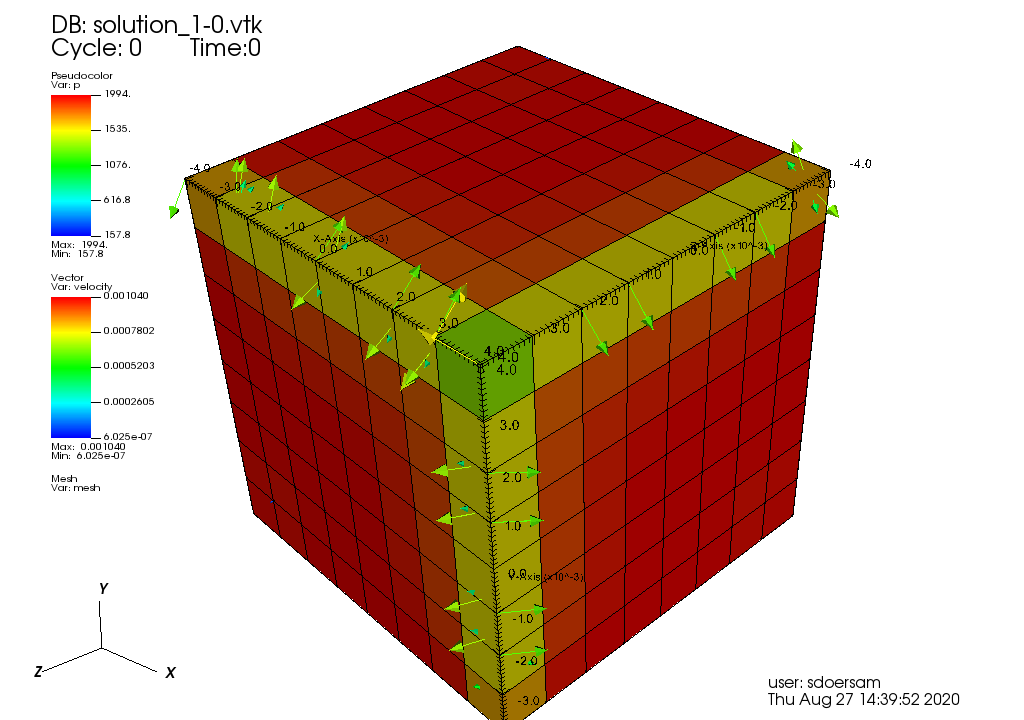Problems with the two-phase flow problem calculated on a hyperball (Step.21)
simon doersam
Hello,
In Step.21 (The two phase flow problem) I replaced the domain "Hyper_cube" with "Hyper_ball".
The numerical solution is unrealistic and appears to be numerical problems at all points,
where the boundary intersects with one of the following planes:
E1: = {x \ in R ^ 3, x1 = x2},
E2: = {x \ in R ^ 3, x1 = x3},
E3: = {x \ in R ^ 3, x2 = x3}.
The pressure and the viscosity are partially negative at these points.
Can someone help me and explain why this is happening?
I am happy for any hint, literature or explanation.
Best wishes,
Simon
Wolfgang Bangerth
> In Step.21 (The two phase flow problem) I replaced the domain "Hyper_cube"
> with "Hyper_ball".
> The numerical solution is unrealistic and appears to be numerical problems at
> all points,
> where the boundary intersects with one of the following planes: E1: = {x \ in
> R ^ 3, x1 = x2}, E2: = {x \ in R ^ 3, x1 = x3}, E3: = {x \ in R ^ 3, x2 = x3}.
>
> The pressure and the viscosity are partially negative at these points.
>
> Can someone help me and explain why this is happening?
template <int dim>
class SaturationBoundaryValues : public Function<dim>
{
public:
SaturationBoundaryValues()
: Function<dim>(1)
{}
virtual double value(const Point<dim> &p,
const unsigned int /*component*/ = 0) const override
{
if (p[0] == 0)
return 1;
else
return 0;
}
};
This simply doesn't make any sense with the geometry you are now using.
Best
W.
--
------------------------------------------------------------------------
Wolfgang Bangerth email: bang...@colostate.edu
www: http://www.math.colostate.edu/~bangerth/
spass...@googlemail.com
 Thank you for your respone. Sorry, I did not think about the
meaning of the modification in step.21. It
was naive. But in my work, I solve only
the Darcy equation (v velocity, p pressure)
on a more complicated mesh, which
is similar to a Hyper_Ball.
I have the same problems. So I tried to find a
“simple case” with the same behavior to understand
the problem.
Thank you for your respone. Sorry, I did not think about the
meaning of the modification in step.21. It
was naive. But in my work, I solve only
the Darcy equation (v velocity, p pressure)
on a more complicated mesh, which
is similar to a Hyper_Ball.
I have the same problems. So I tried to find a
“simple case” with the same behavior to understand
the problem.
For example I solve
the Darcy equation on a "HyperCube" with constant Dirichlet
condition for the pressure (p=p_D on
partial Omega). Then I get the trivial
solution v = 0, p = p_D (=2000).
But if I use a “Hyper_Shell” or
“Hyper_Ball” instead of a “Hyper_Cube”,
then there are problems(see attachments) and I don't get the trivial solution.
Why?
From
the data, I have only an average
pressure. So I choose the pressure on a part of the boundary
constant. Certainly this is not entirely true, but it doesn't seem
that this is my problem. I suppose
the grid related to the Raviart-Thomas elements is the problem. But
I will also think again about my boundary conditions.
Best, Simon
Wolfgang Bangerth
Simon,
> visit0000.pngThank you for your respone. Sorry, I did not think about the
> only the Darcy equation (v velocity, p pressure) on a more complicated mesh,
> a “simple case” with the same behavior to understandthe problem.
> For example I solve the Darcy equation on a "HyperCube" with constant
> Dirichlet condition for the pressure (p=p_D on partial Omega). Then I get the
> trivial solution v = 0, p = p_D (=2000).
> But if I use a “Hyper_Shell” or “Hyper_Ball” instead of a “Hyper_Cube”, then
> there are problems(see attachments) and I don't get the trivial solution. Why?
several steps associated with getting boundary values right:
* You need to generate a geometry
* If you have curved boundaries, you also need to make sure that the different
parts of the boundary have the appropriate manifold objects associated with
them to ensure that the mesh is refined in the correct way
* You need to associate different boundary indicators to different parts of
the boundary
* You need to write a function that for a given points returns the appropriate
boundary value.
I don't know how you implement all of these steps, but you should double check.
